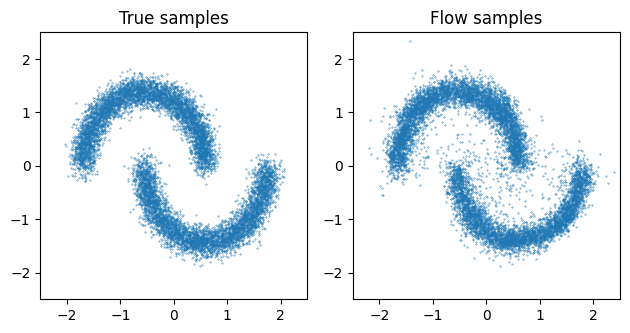Unconditional density estmation#
Here we will use a masked_autoregressive_flow with a RationalQuadraticSpline transformer to approximate the “two-moons” distribution. For a list of available flow architectures, please see flowjax.flows.
Importing the required libraries.
[1]:
import jax.numpy as jnp
import jax.random as jr
import matplotlib.pyplot as plt
from flowjax.bijections import RationalQuadraticSpline
from flowjax.distributions import Normal
from flowjax.flows import masked_autoregressive_flow
from flowjax.tasks import two_moons
from flowjax.train import fit_to_data
Generating the the toy dataset.
[2]:
n_samples = 10000
rng = jr.key(0)
x = two_moons(rng, n_samples)
x = (x - x.mean(axis=0)) / x.std(axis=0) # Standardize
We can now create the flow. We use a normal base distribution, and define the spline transformer to have 8 knots on the interval [-4,4]. Note that we could use other bijections for the transformer (e.g. Affine).
[3]:
key, subkey = jr.split(jr.key(0))
flow = masked_autoregressive_flow(
subkey,
base_dist=Normal(jnp.zeros(x.shape[1])),
transformer=RationalQuadraticSpline(knots=8, interval=4),
)
Training the flow.
[4]:
key, subkey = jr.split(key)
flow, losses = fit_to_data(subkey, flow, x, learning_rate=1e-3)
22%|██▏ | 22/100 [00:14<00:50, 1.55it/s, train=1.54, val=1.53 (Max patience reached)]
We can use the flow to evaluate the density of arbitrary points
[5]:
five_points = jnp.ones((5, 2))
flow.log_prob(five_points)
[5]:
Array([-9.12954, -9.12954, -9.12954, -9.12954, -9.12954], dtype=float32)
and we can sample the flow
[6]:
key, subkey = jr.split(key)
x_samples = flow.sample(subkey, (n_samples,))
fig, axs = plt.subplots(ncols=2)
axs[0].scatter(x[:, 0], x[:, 1], s=0.1)
axs[0].set_title("True samples")
axs[1].scatter(x_samples[:, 0], x_samples[:, 1], s=0.1)
axs[1].set_title("Flow samples")
lims = (-2.5, 2.5)
for ax in axs:
ax.set_xlim(lims)
ax.set_ylim(lims)
ax.set_aspect("equal")
plt.tight_layout()
plt.show()
